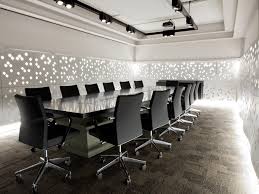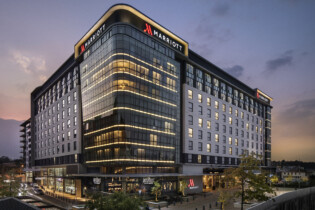|
Choosing the appropriate conference seating style will support the aim of the event and the goals of the presenter. Organisers must fully inspect the conference venue and think everything through from a delegate and presenter point of view.
Conference venue layout and tips
- Ensure easy access to seats and that the aisles are wide enough
- Accommodate people with special hearing, seeing or mobility needs
- Choose adjustable chairs for day-long training
- Place the entrance at the back of the room to avoid distraction
- Check that the speaker can be seen from the back of the room
- Speaker tables can have a skirt around the front to screen belongings
Large Groups (usually more than 40 delegates)
- Cinema / Theatre Style
- Classroom
- Chevron and Modified Chevron
- Banqueting for when meals are served after the conference
 Cinema / Theatre Seating Style Cinema / Theatre Seating Style
This style of conference seating has rows of seats with aisles (3 columns) facing a stage or podium.
Best for – Formal presentations, lectures, Q&A sessions
Downside – No tables for note taking; no interaction between delegates
 Classroom Seating Style This style of conference seating has rows of tables with 2-4 seats each and aisles (3 columns) facing a stage or podium. Classroom Seating Style This style of conference seating has rows of tables with 2-4 seats each and aisles (3 columns) facing a stage or podium.
Best for – Note taking / PCs at presentations, training, sales talks
Downside – limited interaction between delegates
 Chevron Chevron
Chevron style has a centre aisle with rows of 4 seats on either side (2 columns) facing a table, stage or podium. The chairs are in a line and angled inwards, with or without tables. Delegates can interact across the aisle and with the speaker.
Best for – Interaction; table space for notes / PC’s and drinks,
Modified Chevron
This is the same as Theatre style, but the 2 outer columns are angled inwards to give better visibility for the side sections and there is more interaction.
Best for – Same as Theatre but with more interaction for discussions.
 Banqueting Seating Style Banqueting Seating Style
This is the bigger version of Cabaret Style conference seating for small groups; seating between 6 – 10 delegates per round table with a rectangular speaker table at the front. It is used when the conference is followed by a meal. Tables should not be any bigger as it will cramp the room and hamper the dinner service.
Best for – Interactive conference before a meal / award ceremony
Downside – Not all chairs face the front; crowded, noisy over mealtime
Small Groups (usually less than 40 delegates)
- Boardroom
- Hollow Square
- U-Shape
 Boardroom Boardroom
Conference seating is around a long rectangular table with not more than 12 – 15 seats; over 15 and the people at the far end feel left out and form a separate unit.
Best for – Small meetings, training sessions, interviews
Downside – For delegates of the same or similar rank
 Hollow Square / Rectangle Hollow Square / Rectangle
The tables are arranged together to form the shape with a space in the middle, conference seating is around the outside. Suitable for meetings where rank is not an issue.
Best for – Interaction with a facilitator; note taking
Downside – Visuals are awkward to use
 U Shape U Shape
Tables are arranged to form the shape with seating around the outside. There can be a screen or a speaker table at the top of the “U”. The centre area can be used for media camera people, demonstration and role play. Suitable for a maximum of 25 people.
Best for – Press conferences, collaboration, training, brainstorming, notes / PCs
Downside – No more than 25 delegates
Article courtesy of conferences.co.za
|



 Cinema / Theatre Seating Style
Cinema / Theatre Seating Style Classroom Seating Style This style of conference seating has rows of tables with 2-4 seats each and aisles (3 columns) facing a stage or podium.
Classroom Seating Style This style of conference seating has rows of tables with 2-4 seats each and aisles (3 columns) facing a stage or podium. Chevron
Chevron Banqueting Seating Style
Banqueting Seating Style Boardroom
Boardroom Hollow Square / Rectangle
Hollow Square / Rectangle U Shape
U Shape



